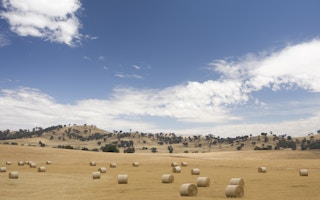Australians may need to get used to coping with more disruptions to their food supply and rising food prices in a warming climate.
But the food produced near our cities - our “city foodbowls” - could play a vital role in increasing the resilience of our food supply, as discussed in a new briefing from our Foodprint Melbourne project.
The urban fringes of Australia’s major cities are some of the most productive agricultural regions in Australia. They also have access to valuable urban waste streams to support food production, including recycled water from city water treatment plants and desalination plants.
Nonetheless, Australia’s city foodbowls are at risk of urban development, and the opportunity to develop them as climate resilient foodbowls could be lost unless their value is recognised in metropolitan planning policy.
Climate shock
The Queensland floods of 2010-11 showed how a sudden extreme weather event could disrupt a city’s food supply. Major transport routes to Brisbane and other cities were cut off and supermarkets began to run short of some food.
And the Millennium Drought demonstrated the impact that drought could have on food prices, when fruit prices in Australia increased 43 per cent between 2005 and 2007, and vegetable prices by around 33 per cent.
Climate change is expected to reduce the capacity for food production across southern Australia due to water scarcity, increasing temperatures and more frequent extreme weather events.
We don’t know exactly how climate change will affect food production, but it is likely that Australia’s major regional foodbowl, the Murray-Darling Basin, will see significant impacts in a severe drying scenario. Wheat and dairy production are predicted to decrease due to climate change. Crops such as fruit and vegetables are likely to be particularly affected.
As the impacts of climate change are felt in Australia’s regional foodbowls, urban and urban fringe (or “peri-urban”) areas of food production around Australian capital cities could become more important sources of fresh foods. Cities have access to resources that are in increasingly short supply, such as water, fertile land and organic waste streams that can be composted to provide fertilisers.
Australia’s city foodbowls
These urban fringes are not widely-recognised as “foodbowls”, but historically they have been an important source of food. Like many world cities, they were typically founded in fertile areas with good access to water. This fed their growing populations.
As cities sprawl, market gardens have been pushed further out and city foodbowls have shrunk, but many are still highly productive. Sydney’s foodbowl produces at least 20 per cent of New South Wales’ total vegetable production, for instance, including the majority of the state’s total production of cabbage, spring onions, shallots and mushrooms.
Melbourne’s foodbowl produces a wide variety of foods, including fresh vegetables, fruit, eggs and meat. It currently has the capacity to meet up to 41 per cent of the food needs of city’s population.

Crops such as lettuce are commonly grown on the urban fringes of cities thanks to close access to markets and labour. Image: Rachel Carey
Some areas of Melbourne’s foodbowl have access to recycled water, such as Werribee to the city’s west and the proposed Bunyip Food Belt to the south-east. The Werribee Irrigation District, next to Melbourne’s Western Treatment Plant, grows around 10 per cent of the vegetables produced in Victoria, including the majority of the state’s broccoli and cauliflower.
Towards the end of the Millennium Drought, vegetable production in this region became dependent on recycled water from the water treatment plant as river levels fell.
But areas such as Werribee are under threat from urban development.
Resilient food supply
The importance of city foodbowls for resilient and sustainable food systems has been recognised internationally.
Cities such as Melbourne and Sydney are fed from a variety of sources - regional, national and global - as well as local. All are important, but urban and urban fringe food production has the potential to increase the resilience of a city’s food supply in a number of ways. These include reducing the dependence of city populations on distant sources of food, and maximising the use of limited natural resources.
If Australia’s capital cities are able to accommodate growing populations in a way that contains urban sprawl and retains their capacity for food production, city foodbowls could contribute to a food supply more resilient from climate change.
For this to happen, city planning strategies need to recognise the significance of city foodbowls for sustainable and resilient city food systems.
![]()
Rachel Carey is research fellow, Deakin University; Jennifer Sheridan, is researcher in sustainable food systems, University of Melbourne, and Kirsten Larsen is manager, food systems research and partnerships, University of Melbourne. This article was originally published on The Conversation.











